I’ve just read a comment from a photographer who said it’s time to stop shooting in black and white. He claimed we don’t see the world in black and white and it was something only done in the past due to the limitations at the time and it’s time to move on. Here’s a number of reasons why I think it’s critical to shoot black and white from time to time, and how it can help nurture your photographic eye.
Ansel Adams, Cartier Bresson, David Bailey, Karsh, Sebastio Salgado, Albert Watson, Peter Lindbergh, Herb Ritts, Irving Penn, Daidō Moriyama, Sally Mann, Avedon – the list of master photographers, alive or dead, who saw black and white not simply as a technical limitation but as a creative choice, could be an entire article in itself. But why did they choose it?

The comment I saw which sparked today's article. What do you think? Do you agree it's time to only shoot color or does black and white still have a place today?
We Shoot Differently When Choosing Black And White
Most photographers ask when should a photograph be converted to black and white. Rarely is the discussion around why a photograph should be black and white from the outset, and that’s fascinating.
While the “when” and “why” are related, shooting in color and then wondering whether to convert the image employs a very different mindset from setting out and seeing the world in black and white, and then working within those confines. Parameters of a world without color forces you to see things differently, to stretch and work out your photographic eye muscles, and that in turn pushes you creatively (at least in my experience it has).
Shooting with black and white film predominantly for the last 6 months has been one of the single most important aspects of my photographic development this last year. It has helped push not only my digital stills work, but I’ve seen the video work I do be shaped by shooting black and white stills. If you look at my Instagram feed or work going onto my Facebook page, you’ll see most of it is in black and white nowadays, with commercial work or video work creeping in from time to time.
I almost guarantee that if you spend some time shooting in black and white, you’ll start to notice some changes in what and how you shoot too. These have been the key reasons I’ve seen the change in my own work:
1. Color No Longer Distracts
Clothing, color temperature differences in ambient light sources, cars and colorful background distractions have stopped being an issue. I still focus on my backgrounds, but I care more about the relationship between my subject and background, rather than a distracting color. It’s freed up that part of my brain. Black and white allows you to begin to think about these key elements (lighting, composition, elements in and out of the frame) that you might otherwise not focus on as much when you’re thinking about making colors work together, or pop.

The color temperatures here all over the place here from multiple sources. I focused more on using some negative space to separate her silhouette and play with leading lines from the wall mounted slats.

The color of everyone's clothing here was super distracting. Black and white allowed me to just focus on the interplay with people and light on a busy commute in Manhattan and pick out this guy in his shades walking determinedly to work.
2. You’ll See Light Differently
What you lose from not being able to capture beautiful golden hour light, you’ll gain back in focusing more on the direction, quantity and quality of light around you. Learning how to read and play with different elements of light in this way is a fantastic skill that parlays directly into shooting video or studio strobes too, trust me.

Light and dark and the interplay between the two contrasting elements can be more interesting to focus on than color relationships
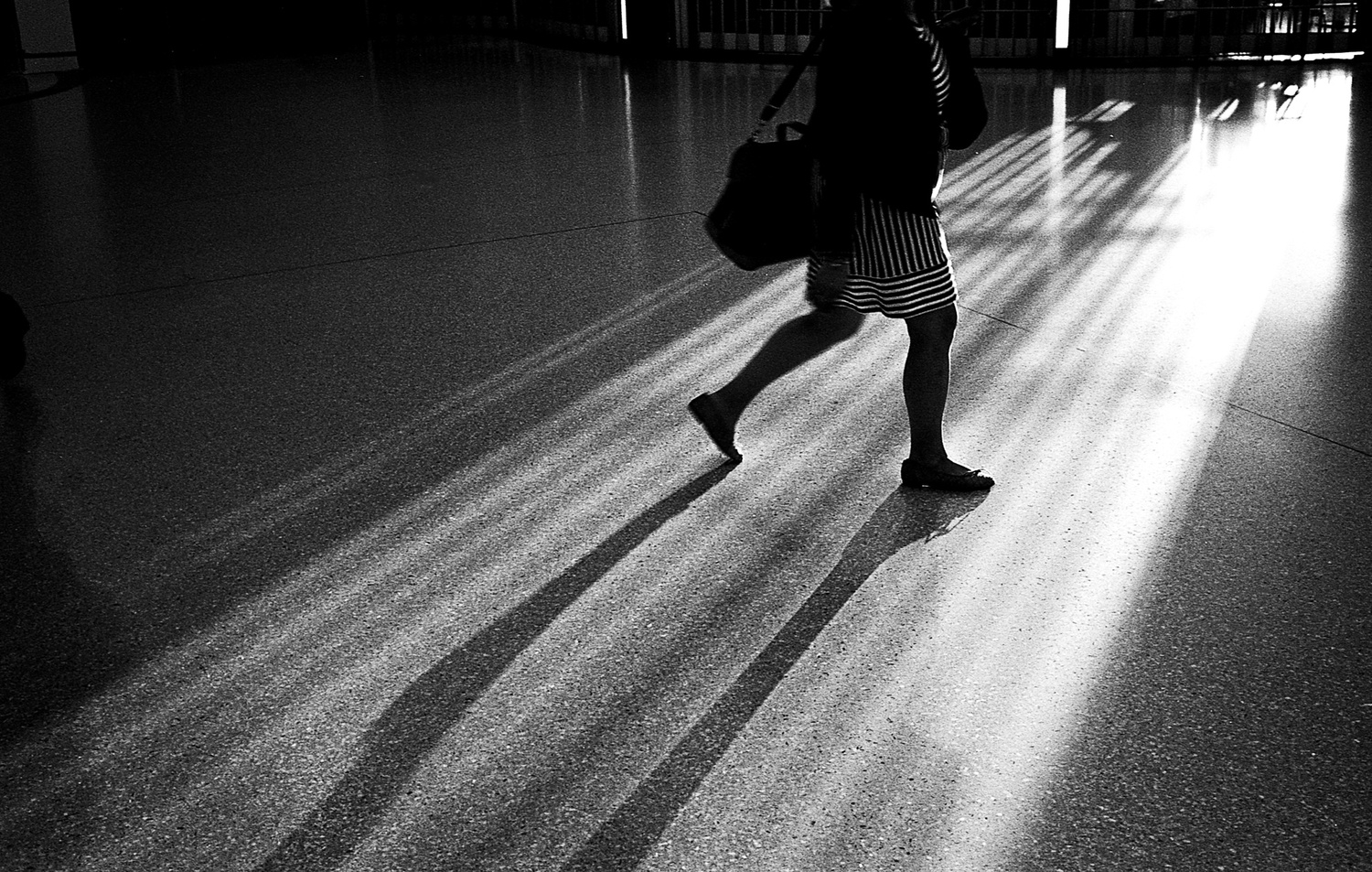
Light and the relationship with your subject (and the shadows that form) as well as other complementary elements (like the lined pattern of this woman's skirt) become the focus, rather than the color of elements in the frame

I liked how the subject's head was outlined by the stark light of his room here, as he looked out onto the street.
3. It Helps Emphasize Emotion
Looking at someone’s face, or into their eyes, without the distraction of color can provide a stronger emotional connection to your subject. It’s not necessarily always the case, but if like me, you often feel more connected to a person in a black and white image over a color image, this could be the reason why. With color gone, it’s purely about the connection you have with the subject.
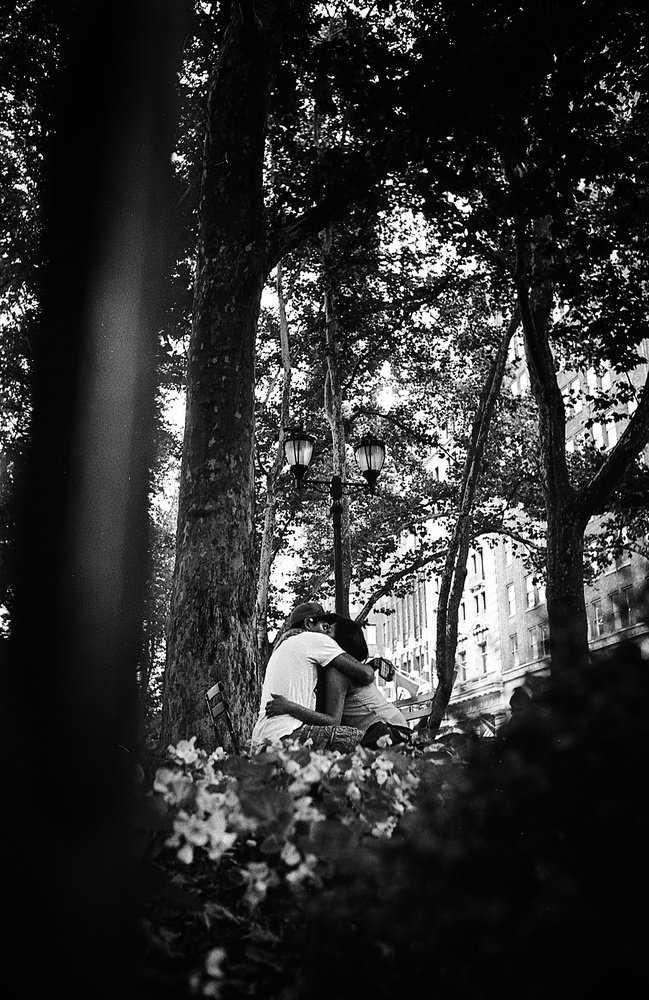
The color of the trees and shrubs, buildings and lamp posts are all irrelevant as the focus becomes the emotional bond between the embracing couple
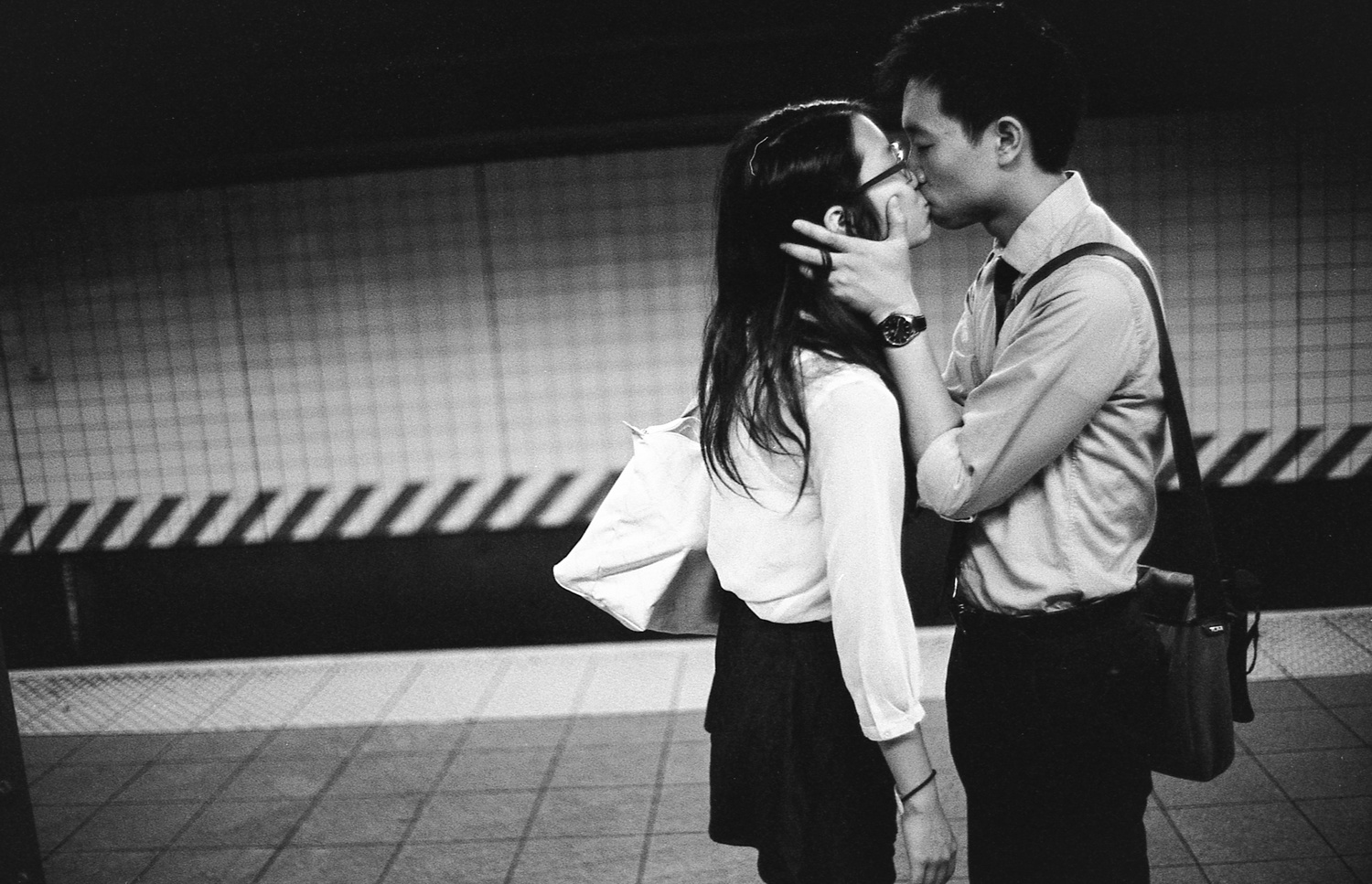
If this was in color, you'd have at least 4 colors in the background and middle ground elements alone, excluding the colors of their clothing and bags. Instead I just focused straight on the split second connection between them as they share a kiss

The love and security this child gets from her mother is palpable. She briefly looked up and I took the shot, her eyes and the tonality of the skin tones here is really interesting to me for some reason
4. The Timeless / Classic Quality From Black And White
One of the most common reasons people want to shoot in black and white today is because it lends a certain timeless quality to the images. This is because we still think of black and white as being a throwback to the photographic past. Of course, it is in terms of black and white was much more prevalent before color, but this is still a great reason to shoot black and white.

This could be a look out of the 1950s. The color of the dress was more of a contemporary peach but without the color of the clothing or accessories, it's more difficult to suggest the era
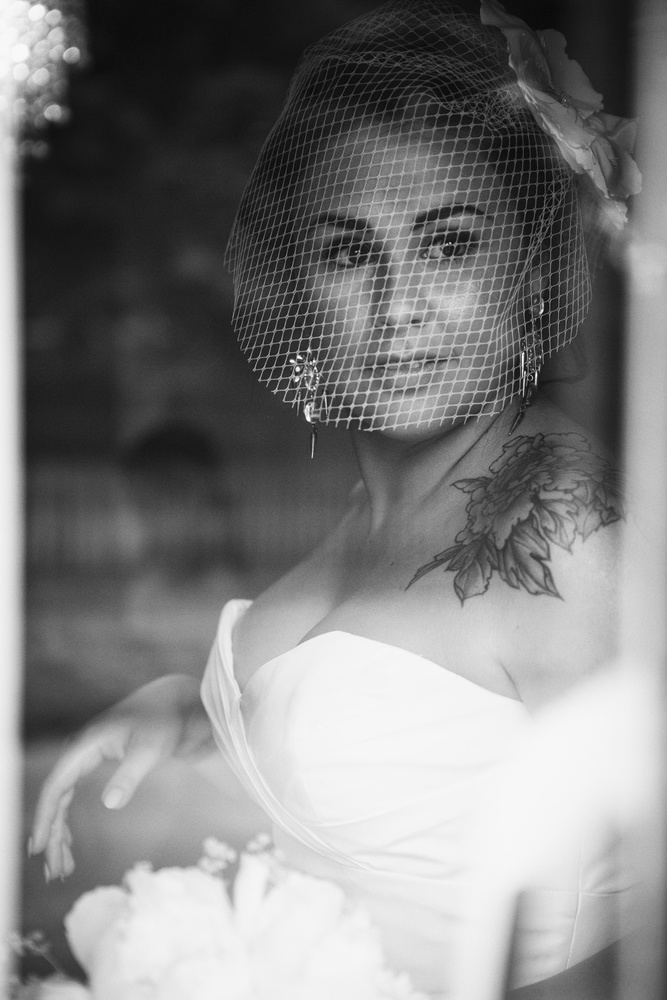
Here the bride has more of timeless look. In color, the tattoo and mix of natural and yellow chandelier light would have been jarring.

In New York, you'll often see people dressed like they are from another era. Again, black and white provides a mystery for the era he could be from, especially as it has muted the colorful inside of the bus
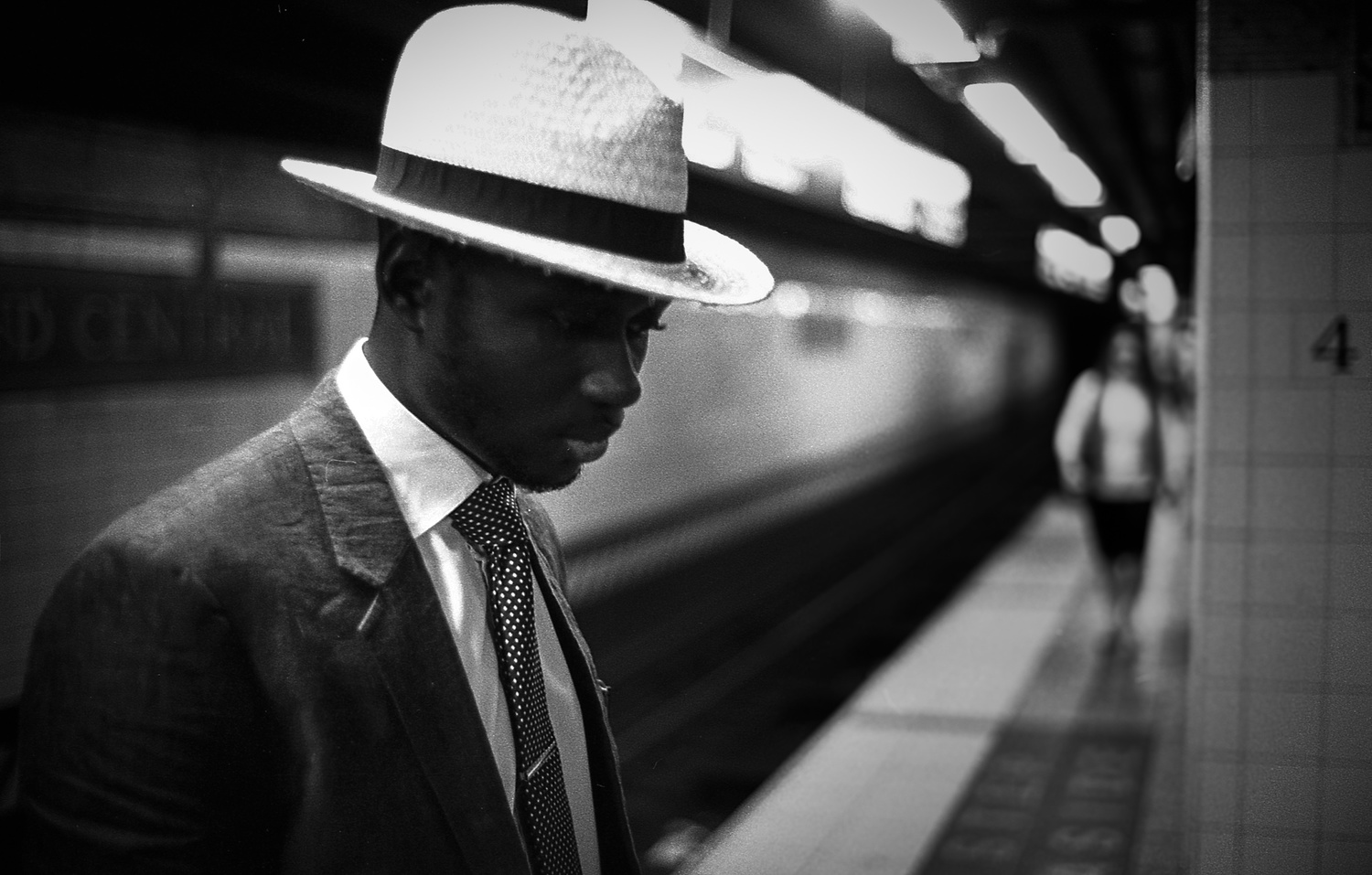
Again this dapper fellow looks like he could easily have been out of the 1950s. Color in the subway, and the person in the background would have certainly not created as much ambiguity in the image
5. It Amplifies How You Use Negative Space
Negative space – the areas of the frame that have nothing in them, are easier to showcase and highlight when shooting black and white. This relates back to minimizing distractions from not shooting in color. You tend to focus on light and dark areas of the frame – and their inter-relationship. Playing with negative space is also useful in separating your subject nicely from the background and give added depth to the image.

Playing with negative space - and the elements in the frame - is much easier to visualize when you see things in black, white and greys

With a similar concept of reflection and negative space, a puddle can become a playground into seeing different spatial arrangements.

Fog atop Twin Peaks in San Francisco provides a great amount of negative space to juxtapose the two view seekers. Their clothing and other elements are muted as distractions because of the lack of color
6. It Highlights Shape, Form and Pattern In The Image
I tend to focus a lot more than I used to on the elements in the frame, both in terms of their shape and form, but also how they relate to one another. You feel like there is a world to explore when you see connecting elements in the foreground and background). Again, color would be distracting here – black and white simplifies the ability to see these elements and play with them.

Without the distraction of color, we see the interplay in lines and patterns between two museum visitors clothing and a background painting at the Met
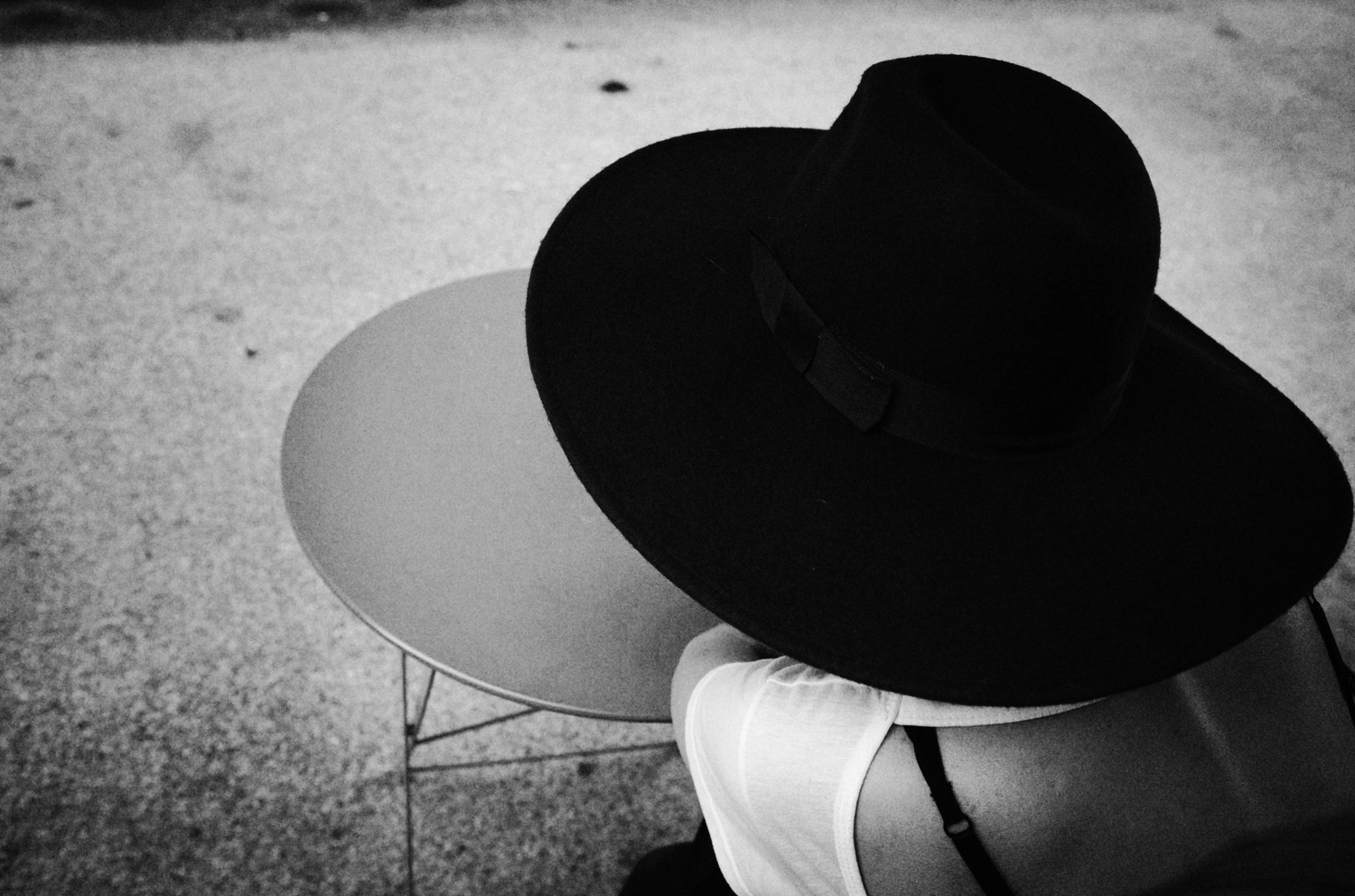
A woman's dark blue hat (here in dark black) becomes a key element in the interplay between her and the table at which she sits.
7. To Highlight Beauty and Skin Tones
It doesn’t matter what race, color or background you happen to be – black and white photography provides wonderful tonal range between the deepest blacks and the whitest whites. Garishly colorful makeup is no longer distracting. Pigments, discoloration and distracting elements of the skin can become less obvious. It’s not hard to see why fashion photographers like Peter Lindbergh have built their entire careers shooting almost exclusively in black and white.

Simple natural window light bathe this young lady in soft light while a black board behind separates her from her environment and focuses our attention

Similarly, this darker skinned model has glowing skin really just from the natural window light and strobe camera right to provide some specular highlight to her skin
8. It Helps Focus On Composition
This reason (and focusing on lighting), are the two strongest reasons for me to shoot in black and white. Of course, composition is not color-dependent. A strong composition is a strong composition. The reason this is important is because – like the others points in this list – black and white compositional elements do away with the distraction of color. Suddenly elements within the frame can relate in a way that might otherwise have been throw off because of jarring color.

Without the background color to distract, here I simply focused on waiting patiently for someone to pass by the guy leaning on the railing to see if i could time a shot to get two elements in the fore and mid ground to match up at the right moment

The two men on Coney Island boardwalk balance one another without their colorful attire being distracting. The contrast between the dark lines in the wooden planks and railing also draw the eye through the image

Using negative fill and not having to worry about colorful clothing, this inverted reflection shot in the rain focuses our attention on the ghostly images walking in a strange, reflected upside down world
So What About Color?
The argument of not shooting black and white because it’s a thing of the past is a little odd to me, especially given that color photography is not necessarily a modern invention. Kodachrome for 35mm cameras has been around since the 1930s. The far more interesting (and possibly meaningful question) may be:“Why is black and white still so prevalent today, given we've been able to shoot color for so long?”.
I still shoot color and love playing with it, but I certainly enjoy the challenge and creative push from shooting in black and white.

Color has it's place. Here, I shot an image with a Fujifilm 400 Superia. I just don't think the reflection of the flag in the rainy table top would have worked if I'd shot this with the black and white Tri-X film i usually shoot
There are very good reasons black and white stills exists today. I challenge anyone not shooting much in black and white to at least shoot RAW and change the setting on your camera LCD to display those JPEGs in ‘monochrome’. See whether or not it yields any change in how – or why – you shoot what you do. The results might surprise you. And if you are shooting black and white, tag me and let me know so I can check out your work, and feel free to post up a link to something you've shot that worked in black and white in the comments below to share with the community.







I totally agree. There is no absolute right or wrong. B&W is available and we should use the it when we feel it serves the purpose of the photo. And yes what you suggest (shooting RAW and display B&W) does help tremendously our thinking of what we do and why. I personnaly love this. But it's not necessarily everyone's bag..
Converting this photo to black and white really makes you look at the eyes more and takes out the distraction of the shirt. https://fstoppers.com/photo/40844
Nice! I like the contrasty light here too, with those deep blacks
+1 for bw images. thank you explaining to those who still need a quantitative explanation of why black and white is still more than relevant.
Nice shot David, looks like the redwoods of northern California!
Very close, Sequoia National Park outside of Bakersfield, CA.
I convert to black and white when the photo has a lot of emotion. If color does nothing for the photo, it's taken away.
I freakin love black and white. Some people might think that it's a cheap way of "saving" pics that have color/exposure problems, but I don't care. :D
I think the biggest problem with B7W is that a lot of people don't know how to properly make a grayscale image using their RGB colour readout and creating proper contrast. I love the image btw.
Shoot how you like, black and white, color, purple, green whatever. Aslong as you're happy with it.
Nice one Dave. I Love shooting Black & white, in fact am about to release a Calendar that is all Black & white. Color has its place no doubt, but if it floats your boat and it looks good, why not !
Those are all valid points. In 2011, I bought a 3 pack of Kodak BW400CN film for a special project. In finishing the other rolls, I rediscovered the classic look of B&W. I made a decision to shoot the year 2012 exclusively with B&W film. It was a year of growth for me and provided the opportunity to work with different B&W contrast filters. It probably took about 2-3 months to finally visualize in B&W.
When someone says they don't like a photo because it is not representative of reality, I stop listening to them.
Every photo is an abstraction of reality. And, yes, B&W is even more of an abstraction, but abstractions have their uses beyond just "looking old" or even "pretty". When you abstract anything in photography, it forces the viewer to engage with it— to look at it, to decipher it, and think about it— in a way that a photograph that better represents "reality" does not.
I love B&W !!!!!!
Love her expression here and the fact she's looking off camera
I don't agree with that photographer at all. B&W can still be very powerful.
Yes there are new, cool, and trendy styles out there but some classics still remain powerful modes of expression. Just because something originated in the past doesn't mean that style has become irrelevant...to say so ignores all the fashion movements over the last 100 years. People still love to see a classic-looking gown on the red-carpet for awards shows...not Uggs with Lulumon pants.
It's such a ridiculous comment that doesn't deserve any merit. As if someone said "We should stop shooting RAW because cameras do a great job of processing JPEGs now, why bother with the extra steps?". We would all look at them like they were an idiot (which, of course, they would be).
Still, a good article with solid points about the creative advantages of black and white photography.
Thanks Andrew
I love shooting black and white. I usually leave my camera set to black and white all the time
Love the composition and framing here Mason, my eye is totally drawn in to the couple sharing a little moment together!
I shoot raw so that I can change my treatment later, but when I shoot people, I always set it to display in monochrome during the session. For some reason, models and sitters are not as critical of their appearance when they look at it in black and white. I have no real idea why, but it works every time.
Now I want to go on a shoot and set my camera to black and white.
Go for it Sara :)
I avoided black and white for a long time until a friend suggested this shot would look good in black and white. I converted it from raw and gave myself a bug to do more. I like converting from raw because it's like having a bag of a million filters. I guess the trick is to use it when color is adds no value or is a distracting element. It can be cheesy in some situations though. Hopefully this isn't one.
I like the image in color, but definitely prefer it in B&W. I think cleaning up the yellows and browns form the sea water and trees, as well as the blues form the sky focuses my eye more on the twisted gnarly structures of the trees and the movement of the water. Thanks for sharing and for doing a side by side
I make images in B/W for all the reasons listed above. Garry Winogrand, Gene Smith, Robert Frank, and a host of others could have shot in color but chose not to. I learned my skills with B/W film, which is extremely valuable in learning to read light. Some digital photog's might say they shoot in B/W mode, or even more ridiculously spend thousands of dollars on a Leica with the Bayer filter removed from the sensor. But why throw away color information which can later be used to adjust dynamic range and local contrast to great effect? I know the argument that removing the Bayer filter on a leica makes each photo site that much more sensitive to shades of gray. If that's your argument, I say go for it and enjoy it. But to me its a case of the emporer's new clothes. To each his own.
I'm not going to be in the market for a Monochrom just yet, no matter how much i enjoy B&W ;)
Love your Manhattan Diaspora business and street faces work Gene, just had a peek :)
"He claimed we don’t see the world in black and white and it was something only done in the past due to the limitations at the time and it’s time to move on."
By this logic, we should also shoot only with standard-length lenses, since we don't see the world in wide-angle or telephoto. Depth of field should always be equivalent to what the human eye sees. No long-exposures or high-speed flash photography, because we don't see that way, either. No macro. No microscope photography. No polarizers or graduated neutral density filters.
The photos of mine that always get the most attention are the ones that are more than one step removed from reality - black and white; long exposure; extremely shallow depth of field; extreme close-up; etc. - that force the viewer to look at something they don't usually see.
Photography isn't supposed to show you what's there. It's supposed to show you what the photographer wants you to look at.
"Photography isn't supposed to show you what's there. It's supposed to show you what the photographer wants you to look at."
Love this
Thank you, David.
I agree with all of the points you made here, but especially so with #2. Setting a mood with lighting is essential to both black and white or color photography, but with a black and white image it really shows if you don't know much about lighting. I think it's a good practice to improve any style of photography.
Agree - and i can see from your work, you definitely have a great instinct for light. Nice port Daniel!
Thank you.
I´ve rediscovered black and white for myself - and became addicted to it! http://www.colinutzphotography.com/
Every picture instantly becomes..'OHH THE HUMANITYYYYYYYYYYYYYYYYYYYYYYY'!
A lot of times, what I'll do is shoot in RAW (color) and when I get the picture into Lightroom, I'll slide the Saturation all the way down to -100, do all my tonal editing, and then watch as the colors POP as I slowly drag the Saturation slider back to the right. The added benefit is that I see the image as a B&W first then in color secondly. That way, I can see if the image benefits more from being in color or not. Check out my 5-in-5 Black & White Challenge entries:
https://www.facebook.com/media/set/?set=a.387063428110741.1073741912.148...
Great article. I disagree that black and white is an easy option, as some people sometimes tell me. Converting to B/w is a skill in itself..http://1x.com/photo/774785/all:user:232028
Thanks Edward
color photography is merely descriptive…B&W is interpretative!!!
If I ever had to choose I would go B&W everytime and 100%.
I usually also shoot RAW and display B&W…my mind doesn't work so well with color…
But, of course a rainbow in a storm in a nice landscape wouldn't look properly in B&W!
When I'm seeing highlights, shadows and converging lines, colors seem to fade anyway. Not every shot should be in B&W and not every shot in color. For this shot, the colors just didn't bring anything to the image.
http://bit.ly/1vRR2FV
One thing people fail to realize is that B&W is a form of art. Some people like to over saturate the image, some people like to desaturate. Also in Hollywood back in the day it took them a while to switch to color, not solely because of cost, and other technical aspects. but because color was not received well by the public. Lots of people left the theaters saying "Why would I want to see a movie in color? Everyday is in color!". B&W was considered out of the ordinary and unique. It was an art form, and still is.
I started a One Camera, One Lens project a few weeks ago and am shooting B/W @ 1:1 daily. It's changed my whole perspective. I shoot an XT-1 in monochrome, so I compose in B/W (which is, admittedly, a crutch). What's amazing is that the RAWs are still in color and generally more balanced and interesting than a lot of my previous work.
I'm 58 and shoot sports for a local paper. I haven't shot film since May of 2003. But from 1972 until then I shot , processed and printed tons of Tri-X and the like. I developed a fondness for BW. Even though I shoot in color, I still see images that scream, "Black and whte!" to me.
I was doing headshots of the local basketball team a couple of weeks ago. I had a young lady waiting in front of the camera while I made final lighting checks. When I went through the images, I came across this otherwise throw-away test shot. I saw something there and went with it. This low-key silhouette demanded BW.
I often recommend beginning photographers to shoot in B&W only for at least the first couple of years. Shooting B&W (and especially setting the LCD preview to monochrome if you're shooting digital) trains the eye to see light & shade, composition, etc., as mentioned in the article.
When I switched to digital in 2007 I shot mostly colour for a while but soon reverted to B&W and have been much happier since doing so. If you can tell a story, convey emotion, engage the viewer with just tones of grey then you're in a better position to make stronger images with colour when it's required. I shoot everything in RAW (of course) and in mono preview mode, intending always to render the images in B&W; occasionally though I find that an image or an entire story works better in colour and will publish the result in colour. However, I'm 100% convinced that pre-visualising the images in B&W makes them stronger regardless of the final treatment and would urge all digital photographers to at least give it a try!
Ciao
Stefano
www.stefanobrunesci.com (NSFW)
Thanks David for a great article on the qualities of Black and White. I've actually been shooting more in Black and White recently (after a long colour phase) and this has given me extra motivation to go on doing so - your street work is great inspiration as well!
Digital gives us the incredible luxury of choice, and there are times, as you mention at the end of your article, where a scene has strong colour elements that might not be so effective in Black and White. I don't feel like I use that choice at times - I often get stuck in phases of colour and phases of black and white, until something jars me into shooting the other for a longer phase, but I'm not sure this is better or worse than flitting between the two constantly. It may be good for developing both, who knows?
Given that you encouraged us to post links, I'm going to post a couple and try not to feel too self-conscious about it! The links are to two projects I've done photographing rehearsals over a couple of months with an important director here in Spain.
The first set were done in Black and White because the rehearsal set was very plain, dull colours (cheap woods and other make-shift props) and the actors often wore clothes that clashed. In short, the colour elements of the scenes weren't adding to the images but detracting from them. Black and White was a clear winner.
http://www.owainshawphoto.com/epv/
Second time around, the set was already built and had this gorgeous red to it that it would have been a shame to lose. Sometimes other colours clashed (light yellow jumpers, I'm looking at you) a little but in general, this was one to do in colour. I also wanted to show the client I could shoot both, a second Black and White project, however good, might have been a bit underwhelming as they'd already seen me do good black and white, strong colour work was going to impress more.
http://www.owainshawphoto.com/actual/
A lengthy reply that doesn't say very much, but thanks once again David for the article, it's given me things to think about, even if not very coherently or very well articulated.
Great article. Inspiring.
I've recently begun shooting monochrome *and* film again after many years of neither. I find it refreshing, and agree with all the points David made in this article.
Great article and fantastic photos. I couldn't agree more with your points about how it can improve your photography composition as well.
essentially our world is an illusion of color and dimension. whatever the world out there is just image in your mind, you create your world around and outside you by simply observing and concentrating on it to be true. the moment you think it is false, it just disappears. the world you see is so tiny to the actual physical universe. your mind is bigger than all of the universes in the universes combined. Black and white photography represent a form of world that our brain really see. yes i know there are colors our there, but the actual objects do not have colors. a silver object only looks silver because your brain think and decode that to be so. when we see an object , they are beyond our visual spectrum. they are just frequency vibrations of energy form in various state.. who told you that x-ray photos are not images of the objects that had been photographed? of course they are!!! in fact if you happen to be able to use gamma ray photography, you will be able to see things that they are almost in reality as they are for real. a camera is a mere mere tool for the your body to capture those visual color frequencies that's all. but those are not the 100% representation of object that they really are in the state. once you have B&W photo, you lose identification with the objects perspectives , and that why Black and White photos are the most beautiful of all, color photos are worthless. a rose is a rose no matter in B&W photo or color photo. colors do not matter. only your eyes think colors matters. that is when your stupidity starts and ignorance begins. you no longer see the objects as they really are!!
In agreement, photos should be taken with the intention of being black and white (either by using film or making a choice when you digitally shoot a scene). I feel that just converting a picture you've taken in colour because it 'works' in black and white isn't really trying. Black and white makes me consider each composition in far more depth, here's one I took on a TLR Rollei.